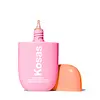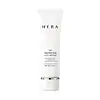What's inside
What's inside
 Key Ingredients
Key Ingredients

 Benefits
Benefits

 Concerns
Concerns

 Ingredients Side-by-side
Ingredients Side-by-side

Zinc Oxide 21.7%
Cosmetic ColorantWater
Skin ConditioningC13-15 Alkane
SolventCaprylic/Capric Triglyceride
MaskingButyloctyl Salicylate
Skin ConditioningPropanediol
SolventMica
Cosmetic ColorantPolyglyceryl-2 Dipolyhydroxystearate
Skin ConditioningPolyglyceryl-3 Diisostearate
EmulsifyingSilica
AbrasiveC12-15 Alkyl Benzoate
AntimicrobialPolyglyceryl-3 Polyricinoleate
EmulsifyingGalactoarabinan
Allantoin
Skin ConditioningFructooligosaccharides
HumectantBioflavonoids
Skin ConditioningGlycoproteins
Skin ConditioningBisabolol
MaskingCeramide Ng
Skin ConditioningLactic Acid
BufferingSodium Hyaluronate
HumectantPalmitoyl Hexapeptide-12
Skin ConditioningCyamopsis Tetragonoloba Gum
Emulsion StabilisingTocopheryl Acetate
AntioxidantDisteardimonium Hectorite
StabilisingGlycerin
HumectantPolyhydroxystearic Acid
EmulsifyingTribehenin
EmollientIsostearic Acid
CleansingLecithin
EmollientXanthan Gum
EmulsifyingSodium Chloride
MaskingPhytic Acid
Pentylene Glycol
Skin ConditioningPhenethyl Alcohol
MaskingCI 77891
Cosmetic ColorantCI 77491
Cosmetic ColorantCI 77492
Cosmetic ColorantZinc Oxide 21.7%, Water, C13-15 Alkane, Caprylic/Capric Triglyceride, Butyloctyl Salicylate, Propanediol, Mica, Polyglyceryl-2 Dipolyhydroxystearate, Polyglyceryl-3 Diisostearate, Silica, C12-15 Alkyl Benzoate, Polyglyceryl-3 Polyricinoleate, Galactoarabinan, Allantoin, Fructooligosaccharides, Bioflavonoids, Glycoproteins, Bisabolol, Ceramide Ng, Lactic Acid, Sodium Hyaluronate, Palmitoyl Hexapeptide-12, Cyamopsis Tetragonoloba Gum, Tocopheryl Acetate, Disteardimonium Hectorite, Glycerin, Polyhydroxystearic Acid, Tribehenin, Isostearic Acid, Lecithin, Xanthan Gum, Sodium Chloride, Phytic Acid, Pentylene Glycol, Phenethyl Alcohol, CI 77891, CI 77491, CI 77492
Water
Skin ConditioningC12-15 Alkyl Benzoate
AntimicrobialEthylhexyl Methoxycinnamate
UV AbsorberPropanediol
SolventButylene Glycol
HumectantBis-Ethylhexyloxyphenol Methoxyphenyl Triazine
Skin ConditioningDiethylamino Hydroxybenzoyl Hexyl Benzoate
UV FilterTitanium Dioxide
Cosmetic ColorantDimethicone
EmollientNiacinamide
SmoothingDiphenylsiloxy Phenyl Trimethicone
Skin ConditioningPEG-100 Stearate
Trisiloxane
Skin Conditioning1,2-Hexanediol
Skin ConditioningSilica
AbrasiveCetearyl Alcohol
EmollientC14-22 Alcohols
Emulsion StabilisingGlyceryl Stearate
EmollientPolyacrylate-13
Aluminum Stearate
Cosmetic ColorantAlumina
AbrasiveAmmonium Acryloyldimethyltaurate/Vp Copolymer
Polyhydroxystearic Acid
EmulsifyingDimethicone/Vinyl Dimethicone Crosspolymer
Skin ConditioningMethoxy PEG-114/Polyepsilon Caprolactone
BufferingStearic Acid
CleansingC12-20 Alkyl Glucoside
EmulsifyingPolyisobutene
C12-15 Alcohols
EmollientParfum
MaskingGlyceryl Caprylate
EmollientDisodium EDTA
Ethylhexylglycerin
Skin ConditioningAdenosine
Skin ConditioningPolysorbate 20
EmulsifyingSorbitan Isostearate
EmulsifyingGlycerin
HumectantTocopheryl Acetate
Antioxidant3-O-Ethyl Ascorbic Acid
Skin ConditioningLactobacillus/Water Hyacinth Ferment
Skin ProtectingMannitol
HumectantEthylhexyl Palmitate
EmollientBHT
AntioxidantLimonene
PerfumingLinalool
PerfumingPentylene Glycol
Skin ConditioningGlucose
HumectantPaeonia Suffruticosa Extract
Skin ConditioningPhenoxyethanol
PreservativePaeonia Albiflora Root Extract
Skin ConditioningSodium Dehydroacetate
PreservativeCarbomer
Emulsion StabilisingSodium Citrate
BufferingPotassium Sorbate
PreservativeTocopherol
AntioxidantHydroxyethyl Acrylate/Sodium Acryloyldimethyl Taurate Copolymer
Emulsion StabilisingCaprylyl Glycol
EmollientPrunus Persica Leaf Extract
EmollientHelianthus Annuus Seed Oil
EmollientLysine
Skin ConditioningArginine
MaskingHistidine
HumectantCitric Acid
BufferingPaeonia Albiflora Flower Extract
TonicBeta-Carotene
Skin ConditioningXylose
HumectantDna
Skin ConditioningBiotin
AntiseborrhoeicMannose
HumectantSodium Chloride
MaskingLecithin
EmollientHydrogenated Phosphatidylcholine
EmulsifyingCopper Tripeptide-1
Skin ConditioningSodium Phosphate
BufferingDextrin
AbsorbentHydrolyzed Hibiscus Esculentus Extract
Skin ConditioningCholesterol
EmollientFucose
Skin ConditioningDipalmitoyl Hydroxyproline
Skin ConditioningAcrylates/Stearyl Methacrylate Copolymer
Emulsion StabilisingPotassium Chloride
Potassium Phosphate
BufferingMagnesium Chloride
Hydrolyzed Millet
Skin ConditioningCalcium Chloride
AstringentWater, C12-15 Alkyl Benzoate, Ethylhexyl Methoxycinnamate, Propanediol, Butylene Glycol, Bis-Ethylhexyloxyphenol Methoxyphenyl Triazine, Diethylamino Hydroxybenzoyl Hexyl Benzoate, Titanium Dioxide, Dimethicone, Niacinamide, Diphenylsiloxy Phenyl Trimethicone, PEG-100 Stearate, Trisiloxane, 1,2-Hexanediol, Silica, Cetearyl Alcohol, C14-22 Alcohols, Glyceryl Stearate, Polyacrylate-13, Aluminum Stearate, Alumina, Ammonium Acryloyldimethyltaurate/Vp Copolymer, Polyhydroxystearic Acid, Dimethicone/Vinyl Dimethicone Crosspolymer, Methoxy PEG-114/Polyepsilon Caprolactone, Stearic Acid, C12-20 Alkyl Glucoside, Polyisobutene, C12-15 Alcohols, Parfum, Glyceryl Caprylate, Disodium EDTA, Ethylhexylglycerin, Adenosine, Polysorbate 20, Sorbitan Isostearate, Glycerin, Tocopheryl Acetate, 3-O-Ethyl Ascorbic Acid, Lactobacillus/Water Hyacinth Ferment, Mannitol, Ethylhexyl Palmitate, BHT, Limonene, Linalool, Pentylene Glycol, Glucose, Paeonia Suffruticosa Extract, Phenoxyethanol, Paeonia Albiflora Root Extract, Sodium Dehydroacetate, Carbomer, Sodium Citrate, Potassium Sorbate, Tocopherol, Hydroxyethyl Acrylate/Sodium Acryloyldimethyl Taurate Copolymer, Caprylyl Glycol, Prunus Persica Leaf Extract, Helianthus Annuus Seed Oil, Lysine, Arginine, Histidine, Citric Acid, Paeonia Albiflora Flower Extract, Beta-Carotene, Xylose, Dna, Biotin, Mannose, Sodium Chloride, Lecithin, Hydrogenated Phosphatidylcholine, Copper Tripeptide-1, Sodium Phosphate, Dextrin, Hydrolyzed Hibiscus Esculentus Extract, Cholesterol, Fucose, Dipalmitoyl Hydroxyproline, Acrylates/Stearyl Methacrylate Copolymer, Potassium Chloride, Potassium Phosphate, Magnesium Chloride, Hydrolyzed Millet, Calcium Chloride
 Reviews
Reviews

Ingredients Explained
These ingredients are found in both products.
Ingredients higher up in an ingredient list are typically present in a larger amount.
C12-15 Alkyl Benzoate is made up of Benzoic Acid and long chain alcohols. It has a low molecular weight.
C12-15 Alkyl Benzoate is an emollient and texture enhancer. Due to its solubility, it is often used in sunscreens to help evenly distribute active ingredients.
As an emollient, C12-15 Alkyl Benzoate helps soften and hydrate your skin. Emollients create a film on your skin that traps moisture within.
This ingredient has been reported to cause eye irritation.
Learn more about C12-15 Alkyl BenzoateGlycerin is already naturally found in your skin. It helps moisturize and protect your skin.
A study from 2016 found glycerin to be more effective as a humectant than AHAs and hyaluronic acid.
As a humectant, it helps the skin stay hydrated by pulling moisture to your skin. The low molecular weight of glycerin allows it to pull moisture into the deeper layers of your skin.
Hydrated skin improves your skin barrier; Your skin barrier helps protect against irritants and bacteria.
Glycerin has also been found to have antimicrobial and antiviral properties. Due to these properties, glycerin is often used in wound and burn treatments.
In cosmetics, glycerin is usually derived from plants such as soybean or palm. However, it can also be sourced from animals, such as tallow or animal fat.
This ingredient is organic, colorless, odorless, and non-toxic.
Glycerin is the name for this ingredient in American English. British English uses Glycerol/Glycerine.
Learn more about GlycerinLecithin is a term for a group of substances found in the cell membranes of plants, animals, and humans. They are made up of mixture of phospholipids.
This ingredient has emollient and emulsifying properties.
As an emollient, lecithen helps soften the skin and creates a barrier to keep moisture in.
As an emulsifier, it also helps prevent water and oil ingredients from separating. Lecithin can also help ingredients be better absorbed by the skin.
This is because the phospholipids in lecithin produce liposomes. Liposomes help other ingredients get through the skin barrier.
Depending on the source of this ingredient, lecithin may not be fungal acne safe. This is because some sources of lecithin come from soybean oil, which may feed the malassezia yeast that feeds fungal acne.
We recommend reaching out to the brand you are purchasing from to inquire about the source of their lecithin.
Some other names for this ingredient include soy lecithin and deoiled soy lecithin.
Learn more about LecithinPentylene glycol is typically used within a product to thicken it. It also adds a smooth, soft, and moisturizing feel to the product. It is naturally found in plants such as sugar beets.
The hydrophilic trait of Pentylene Glycol makes it a humectant. As a humectant, Pentylene Glycol helps draw moisture from the air to your skin. This can help keep your skin hydrated.
This property also makes Pentylene Glycol a great texture enhancer. It can also help thicken or stabilize a product.
Pentylene Glycol also acts as a mild preservative and helps to keep a product microbe-free.
Some people may experience mild eye and skin irritation from Pentylene Glycol. We always recommend speaking with a professional about using this ingredient in your routine.
Pentylene Glycol has a low molecular weight and is part of the 1,2-glycol family.
Learn more about Pentylene GlycolPolyhydroxystearic Acid is a soft wax made from castor oil.
It is is a texture thickener, emulsifier, and film-former. Emulsifiers prevent ingredients from separating, such as oils and waters.
Polyhydroxystearic Acid may not be fungal acne safe.
Learn more about Polyhydroxystearic AcidPropanediol is an all-star ingredient. It softens, hydrates, and smooths the skin.
It’s often used to:
Propanediol is not likely to cause sensitivity and considered safe to use. It is derived from corn or petroleum with a clear color and no scent.
Learn more about PropanediolSilica, also known as silicon dioxide, is a naturally occurring mineral. It is used as a fine, spherical, and porous powder in cosmetics.
Though it has exfoliant properties, the function of silica varies depending on the product.
The unique structure of silica enhances the spreadability and adds smoothness, making it a great texture enhancer.
It is also used as an active carrier, emulsifier, and mattifier due to its ability to absorb excess oil.
In some products, tiny microneedles called spicules are made from silica or hydrolyzed sponge. When you rub them in, they lightly polish away dead skin layers and enhance the penetration of active ingredients.
Learn more about SilicaChances are, you eat sodium chloride every day. Sodium Chloride is also known as table salt.
This ingredient has many purposes in skincare: thickener, emulsifier, and exfoliator.
You'll most likely find this ingredient in cleansers where it is used to create a gel-like texture. As an emulsifier, it also prevents ingredients from separating.
There is much debate on whether this ingredient is comedogenic. The short answer - comedogenic ratings don't tell the whole story. Learn more about comegodenic ratings here.
The concensus about this ingredient causing acne seems to be divided. Research is needed to understand if this ingredient does cause acne.
Scrubs may use salt as the primary exfoliating ingredient.
Learn more about Sodium ChlorideTocopheryl Acetate is AKA Vitamin E. It is an antioxidant and protects your skin from free radicals. Free radicals damage the skin by breaking down collagen.
One study found using Tocopheryl Acetate with Vitamin C decreased the number of sunburned cells.
Tocopheryl Acetate is commonly found in both skincare and dietary supplements.
Learn more about Tocopheryl AcetateWater. It's the most common cosmetic ingredient of all. You'll usually see it at the top of ingredient lists, meaning that it makes up the largest part of the product.
So why is it so popular? Water most often acts as a solvent - this means that it helps dissolve other ingredients into the formulation.
You'll also recognize water as that liquid we all need to stay alive. If you see this, drink a glass of water. Stay hydrated!
Learn more about Water